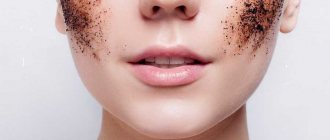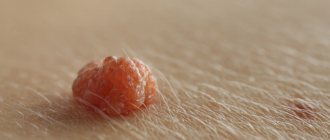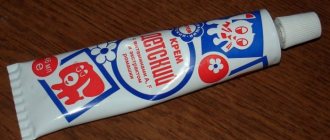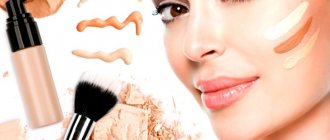In winter, the skin is exposed to the negative effects of wind and cold, resulting in flaking, redness and a feeling of tightness, the skin becomes dry, which makes it vulnerable to allergens, bacteria and viruses. In order to prepare your skin for frost, you must follow the rules of winter care.
Winter facial skin care - rules and mistakes
Not many people know what the basics of proper care should be, and they make mistakes, causing even more harm. Among the main errors it should be noted:
- inconsistency of care products with skin type - many people believe that in winter the skin type changes, in fact this is not so - the dermis simply becomes drier, which requires adjustments to usual care;
- insufficient hydration - there is a common misconception that moisturizing creams should not be used in winter, since the water in them freezes in the cold and harms the skin, this is not true - not only the skin, but also the air in the room should be moisturized;
- hot shower/wash - it is recommended to use warm water, since higher temperatures destroy the lipid barrier and lead to dehydration;
- aggressive peelings and alcohol-based cleansers - in winter they should be replaced with softer ones marked “for sensitive skin”;
- classic two-time care - in winter, the skin needs protection before each exit; creams should be applied no later than 20 minutes before going out;
- superficial care - when caring for your skin using cosmetic products, you should remember the need for proper nutrition and maintaining a water-salt balance.
How to keep your skin beautiful and healthy in winter
In our health section, we have already talked about how the skin is a kind of “mirror of the health” of our body. And in order for it to conscientiously perform its many functions, it is necessary to pay special attention to it. Dermatologists from City Clinical Hospital No. 52 talk about the features of skin care in winter
And
.
What problems await our skin in winter? Firstly, the air in the room is dry from heating appliances. Secondly, frost and cold wind outside. Thirdly, a sharp change in temperature when you leave the house to go outside. Not only exposed parts of the body suffer, but also those protected by clothing. Therefore, we will focus on all possible areas of the skin that require close attention in the winter season, and will start with the facial skin that is most exposed to environmental factors.
Face
If we at least somehow protect and shelter all other parts of the body from frost and wind, then the face takes all the blows of winter weather. Under the influence of low temperatures and wind, the skin becomes dry, more sensitive, and wrinkles easily form on it. Low temperatures constrict blood vessels, and the skin of the face lacks nutrients brought by the blood.
Thus, winter facial care should include additional moisturizing and nourishing of the skin, as well as protection from frost and wind.
Moisturizing
After washing and cleansing your face, be sure to use a tonic or lotion - it forms a film that retains moisture in the skin.
In windy winter weather and when playing sports outdoors, you should not use moisturizer. In winter, it is recommended to apply this cream to the face at night, and in the morning, before going outside, use a nourishing one, it will protect against frost. If you use two types of cream of the same brand - moisturizing and night, simply swap them. By the way, in winter, foundation made with a fatty base protects well from the cold.
If you usually used moisturizers for oily skin, then in winter switch to products for normal skin.
If your skin is normal, use moisturizers for dry skin. If your skin is dry, use your usual moisturizer, but 1.5 - 2 times more often than at other times of the year. Nutrition
The nourishing cream applied in the morning should be thick and greasy, and even in our middle zone it should have protection from UV radiation - with a minimum factor of 15 SPF. The cream is applied ten minutes before applying foundation. If you're going on a ski holiday, your morning cream should have a protection rating of at least 30, and preferably 50. The same goes for your lipstick.
Pay attention to products from Russian manufacturers. Facial care products from the factories “Svoboda”, “Nevskaya Kosmetika”, “Black Pearl” take into account the specifics of the climate of the middle zone, which is significantly different from the European one. Also consider cosmetics produced in northern European countries (Finland, Sweden), which take into account the climatic conditions, including our country, and combine components that provide protection and nutrition. Pay attention to the content of 100% natural oils, herbal extracts, vitamins A and E in face cream, including eyelid cream, which are the main active substances: nourish and soften the skin, activate metabolic processes in it, increase elasticity and elasticity. Creams containing emollient components (squalane, rep and avocado phytosterols, macadamia oil, argan, jojoba), oligoelements (zinc and silicon), and essential fatty acids (linoleic and linolenic) will be useful.
LIPS
All the same rules apply to protecting lips in winter. Frost and wind, and especially the habit of breathing through the mouth in the cold, cause peeling of the lips. Therefore, at this time of year, you should always have hygienic lipstick or a special moisturizing balm on your lips. Pay attention to the composition of your winter lipstick: it should be based on beeswax and fat and contain a sun protection factor of at least 20.
If your lips are flaky, use a special lip scrub. At home, it is useful to lubricate your lips with honey or cucumber juice. Vegetable oils - castor, olive, applied for 10 minutes daily are wonderful nourishment for the lips. If desired, you can add a couple of drops of lemon to the oil.
BODY
In winter, no matter how strange it may seem, you should not take a hot shower - only a warm one. Hot water increases heat and water transfer, and the skin dries faster. a long stay in hot water will completely deprive the skin of its protective fat layer, leading to an increase in its dryness. You shouldn’t completely deny yourself the pleasure of soaking in the bath, but you need to remember the duration of the pleasure - no more than 15 minutes, and the water temperature should not exceed 40°C. In winter, do not use regular soap, prefer moisturizing cream soap or shower gel containing cream. Once a week, you can use a body scrub instead of shower gel or before it to remove dead cells from the surface layer of skin. After a shower, use body milk, applying it evenly over the entire surface with massaging movements.
HANDS
The skin of your hands is very delicate; it instantly reacts to lack of care, becoming dry, tight and cracked. The “winter” rule is that you should always wear mittens or gloves outside. You should stop using antibacterial hand cleansers - they lead to dry skin. Try to wash dishes and clean the house only with gloves.
Thick creams are suitable for hand skin care. At night, it’s good to make special masks: apply a thick layer of cream to your hands, put on cotton gloves and do nothing for at least 2 hours (you can go to bed).
LEGS
In winter, you need to take care of your feet even more carefully than in summer. Due to constant contact with woolen fabrics and dense synthetics (socks and tights), insufficient air exchange due to wearing closed shoes, the skin of the feet becomes drier than usual. Hyperkeratosis occurs - thickening of the upper layer of the epidermis and, unfortunately, a regular pedicure does not help in such cases. It is necessary to use daily creams and other cosmetics that contain keratolytics - active substances that soften and remove dead skin (they contain salicylic and lactic acid, urea), as well as foot scrubs (they contain coarser exfoliating components than scrubs for body).
To soften rough skin on the feet, oil wraps help: warm oil (olive, peach or coconut) is applied to the feet, and woolen socks are put on the feet. After 30 minutes, the oil is washed off with warm water. At night you need to use a nourishing foot cream, thicker than in the summer. Before going to bed, it is also advisable to do a foot massage - it relieves fatigue and stimulates metabolic processes in the body. In the morning after a shower, before putting on tights and socks, it is useful to use quickly absorbing moisturizers with a deodorizing effect - to prevent dryness and eliminate unpleasant odors during the day. And take it as a mandatory rule: to allow your feet to “breathe”, change your shoes indoors, change your winter shoes to lighter replacement ones.
HUMIDIFYING FROM THE INSIDE
You also need to take care of moisturizing the skin from the inside, for which you should drink more fluid. It can be plain water, juice, compote. Tea and coffee, on the contrary, promote faster removal of moisture from the body - they should not be abused. The average amount of liquid taken per day in winter should be at least 2 liters.
INDOOR MICROCLIMATE
Winter skin care is not only masks, tonics and creams. This also means maintaining adequate temperature and humidity conditions in the apartment and at work.
To reduce the degree of dehydration and drying of the skin (and this is due to central heating radiators and air conditioning), it is necessary, if possible, to maintain the room temperature at 18-20 ° C and be sure to use air humidifiers (steam humidifiers or ultrasonic water sprayers), especially at night. If it is not possible to use special devices, you can simply pour water into wide containers and place them on window sills or cabinets - the water, evaporating at room temperature, will create an optimal level of humidity.
IF YOU HAVE PROBLEMS
If alarming symptoms occur on the skin or during an exacerbation of chronic skin diseases at any time of the year, dermatologists from City Clinical Hospital No. 52 will come to your aid. You can make an appointment by phone or through the Make an appointment form.
Cold allergies - symptoms, basic care and prevention.
Cold allergy is a hypersensitivity reaction caused by exposure to low temperatures, which primarily manifests itself in the form of skin rashes such as urticaria and contact dermatitis. The main symptoms appearing on the skin:
- redness;
- itching;
- local swelling.
In addition, symptoms of cold allergies include general malaise, shortness of breath, nasal congestion, headaches, and conjunctivitis. When caring for skin with manifestations of cold allergies, you should adhere to a number of rules:
- gentle cleansing of the skin with products containing vitamins C and E;
- use soft sponges for washing, avoid harsh mechanical scrubs and chemical exfoliants; during the period of remission, gentle exfoliants should be used;
- Before going outside, apply a protective nourishing cream with a dense texture, which contains allantoin, panthenol, vitamins E and F, and bisabolol.
Manifestations of cold allergies can be avoided if preventive measures are taken in a timely manner: treat the skin with nourishing skin care products, reduce the time spent in the cold if possible, breathe through your nose outside, choose exclusively warm clothes and shoes, and adhere to a balanced diet.
Caring for other parts of the body
Not only the face needs care in winter, but also other parts of the body - lips, hands and the body as a whole.
Lip care
To care for your lips, you need to use the following products and procedures:
- scrubs;
- peeling (the number of procedures is reduced);
- massage with fingertips;
- for removing makeup;
- nourishing masks;
- decorative cosmetics for frost protection.
Hand care
The skin of your hands also needs care in winter. For this they use;
- vitamin masks;
- beeswax;
- products based on aloe juice;
- honey;
- vegetable malas - cocoa, jojoba, avocado.
SPF in winter. Why is it important!
The opinion that ultraviolet radiation is dangerous for the skin only in warm seasons is a misconception. In winter, the skin is susceptible to the harmful effects of UV rays, even in cloudy weather. UVA radiation (a type of ultraviolet rays active in winter) is one of the main causes of dry skin, wrinkles and hyperpigmentation.
In order for SPF products to effectively protect the skin, it is necessary to follow their application technique. First, daytime care products are applied, then after 15–20 minutes, cream with SPF is applied.
Exfoliate excess
During the cold season, metabolic processes slow down. The skin does not renew itself as quickly as we would like - dead scales of the stratum corneum linger on the surface of the face, its relief becomes less even. This is often accompanied by pimples: sebum cannot escape, creating a favorable environment for the growth of bacteria.
Regular exfoliation will help get rid of dead cells and signs of chapping. In order not to injure the hydrolipidic mantle of the skin, it is advisable to replace highly abrasive scrubs with scrub-masks with delicate exfoliating particles or peelings with AHA acids.
Should I use moisturizer in cold weather?
Yes! Refusal of moisturizers in winter leads to dehydration of the skin, which is exposed to the destructive effects of dry air, wind, cold and temperature changes. The skin becomes tight, dull and rough, and oily skin becomes even more greasy due to loss of moisture. Winter day cream should contain vitamins and vegetable oils. Among others, you should choose those products in which protective and nutritional components predominate over moisturizing ones. To moisturize the skin in winter, you should give preference to creams that contain Shea Butter ( Shea butter ), Avocado Oil ( avocado oil ), Tocopherol ( vitamin E ).
Is it possible to do peelings and scrubs in winter?
The application of a scrub and the peeling procedure perform a single task - they help smooth the skin and exfoliate the top layer of dead cells. As a result, the skin is strengthened, making it better able to withstand frost and temperature changes.
Therefore, scrubs and peeling become especially important in winter. They are accompanied by the use of a nourishing cream that accelerates tissue restoration processes. These products use natural ingredients:
- rose oil, lemon oil;
- lactic, mandelic acid;
- papaya;
- kelp.
Caring for different skin types in winter
In winter, the skin becomes drier, but this does not mean that its type changes. In order to ensure proper care and protection of the skin from the effects of wind and cold, you should select products intended for the “neighboring”, drier type. For example, mattifying products for oily skin should be replaced in winter with light gels/creams for combination skin. The general care correction scheme is as follows:
- products for oily skin types are replaced with products for combination skin types;
- products for combination type - to products for normal skin;
- products for normal skin - products for dry skin;
- products for dry skin – to products for very dry skin.
In general, caring for dry skin in winter involves the use of mild cleansers and scrubs containing placenta, nourishing creams and moisturizers (apply in advance of going outside). Oily skin is less susceptible to dryness; to care for it, you should use cleansing foams, reducing the work of the sebaceous glands, creams and mud masks. Since combination skin type is distinguished by oily skin in the T-zone and dry skin in other areas, for care after thorough cleansing with gels and mousses for washing, it is necessary to combine different products. Nourishing creams are suitable for the T-zone, while oilier creams are suitable for other zones.
Normal skin
This type does not suffer from excessive sebum production or lack of moisture. However, even normal skin needs to be taken care of in winter to maintain a stable condition and prevent overdrying.
For normal skin of the face and body, a cream with a light texture is suitable; a denser one may provoke additional sebum production. It is better to use a product that absorbs quickly and is suitable as a base for makeup. Before using the cream, do not forget to cleanse your skin - morning and evening - and wash your face with cool water.
Hand skin requires special attention
In winter, hands also require careful care, since in the cold the skin begins to crack, turn red, its protective properties are weakened, and its nutrition deteriorates. This not only worsens the appearance of the skin on your hands, but also accelerates the aging process.
In winter, it is advisable to wear gloves or mittens to avoid contact with frosty air. You shouldn't wash your hands before leaving the house, but applying a little rich cream won't hurt. If you notice excessive dryness of the skin on your hands due to the heating system operating at full power and you are not going to leave the room in the next few hours, you can use creams with a high moisturizing effect. On the contrary, such creams should not be used in the cold - the moisture contained in them will freeze and cause skin irritation. You can also recommend oil baths for your hands, which simultaneously warm them and nourish the skin.
You should also pay attention to clothing
Our skin must “breathe”, this is very important. In winter, she most often loses this opportunity - too warm clothes, sometimes in several layers, do not allow this. If you want to maintain natural ventilation, you should wear cotton underwear; if possible, you should avoid wearing too tight clothing. But even in this case, constant contact of the skin with clothing can cause it to dry out and peel, then you should use body milk or moisturizing gels more often.
What other areas are particularly susceptible to winter conditions?
Hands
Sensitivity of the hands is explained by frequent exposure to cold and running water. Remember to keep them moisturized and protected with gloves.
Pay special attention to your hands. It is necessary to take care of your skin in winter by applying a rich cream twice a day. This is the best way to avoid cracks and damage.
Helpful tip: never wash your frozen hands with hot water! Thermal shock causes changes in blood vessels. Wash your hands with warm water.
Lips
The skin on the lips is thinner than the skin on the rest of the face; in winter, it cracks easily and experiences a burning sensation and tightness. Use a lip stick as often as possible without waiting for them to crack.
Moisturize your lips any time of day with our revitalizing lip balm, formulated with Vitamin E for optimal protection from the cold. You can also apply a thick layer of balm and leave it on overnight so that when you wake up, your lips will be perfectly soft and tender.
Body
In winter, we are dressed from head to toe, and wool and synthetics can cause irritation on the body. If the skin receives enough nutrition, then itching under a pullover can be avoided!
An invigorating hot shower also leads to irritation. Therefore, we recommend showering at a temperature of 37°C, i.e. at body temperature.
Helpful tip: After a bath or shower, dry your body with a towel carefully so as not to cause irritation.
What to look for in cosmetics
If in summer the skin needs active hydration, then in winter nutrition and protection come first. To choose the optimal product, you need to carefully study its composition.
Active Hydrating Cream, 100 ml
Protect Lipo Cream with mink oil, 50 ml
Winter barrier cream with crambe oil Winter Cream, 50 ml
Look for the following ingredients in winter care products:
- vitamins A, B, C, D, E, F
- nourish the skin and increase its endurance; - microelements (magnesium, calcium, zinc)
- contribute to the active functioning of cells; - collagen and elastin
- increase skin elasticity, prevent the formation of wrinkles, slow down the aging process in cells; - oils
- restore the lipid layer of the epidermis, smooth and soften the skin; - ceramides
- fill the skin with vital energy and increase its protective properties; - plant extracts
- saturate epidermal cells with moisture and nutrients; - panthenol and allantoin
- have a softening and calming effect; - hyaluronic acid
- retains moisture in cells and prevents skin from drying out.
Make restorative masks
A nourishing cream-mask for the face from the Natura collection moisturizes and soothes the skin - just what you need after an icy wind or snowstorm. The main active ingredient of the mask is shea butter. It saturates cells with fatty acids, restores, slows down age-related changes and creates an invisible protective barrier on the skin that prevents moisture evaporation. The cream mask contains no alcohol, parabens, silicones or artificial colors. It is suitable for all skin types, including sensitive. You can take care of your skin without being distracted from your daily routine: just apply the mask in a thick layer, leave for 10 minutes, and then remove the excess with a napkin.
Meals should be varied and include more fluids
Our diet and drinking regime are especially important for the skin in winter, when the body lacks vitamins and moisture reserves quickly decrease. As a result, the skin becomes dry and lifeless, but this can be corrected. To do this, you need to eat fruits, vegetables, juices, lactic acid products, greens, cereals and grains, and fish. You should drink enough liquid, it can be raw water, green tea, cranberry or lingonberry juice, or rosehip decoction. All this will not only reduce skin problems, but also help the immune system fight viral infections and colds.
Charge yourself with vitamins
Fresh fruits and vegetables are rather rare in winter. A lack of vitamins and minerals immediately affects the skin: it becomes dull, acquires an uneven texture, and recovers more slowly.
Sea buckthorn and rose hips give a powerful boost of vitamins. A cup of berry tea is a great way to warm up after a winter walk, while your face is taken care of by the “Clean Line” nourishing cream with the same “delicious” composition. Sea buckthorn oil and rosehip extract saturate cells with beneficial substances, stimulate metabolic processes, make the skin elastic and help smooth out fine wrinkles. Due to its rich vitamin and mineral composition, sea buckthorn is a classic component of anti-aging creams. Rosehip is a real storehouse of vitamin C. As part of the cream, it helps preserve the beauty and youth of the skin: it works as an antioxidant, stimulates collagen synthesis, and regulates cell renewal.
How to take care of your skin in winter
Remember a few important rules that will help maintain the beauty and health of your skin during the cold season.
- In winter, you should avoid using cleansers based on simple alcohols. Such products will dry out the skin greatly, and this is not at all what is needed in the cold season. It is better to replace gels and lotions with soft foams or milk.
- Constant skin care is necessary in any season, but regularity in winter is especially important. It is impossible to nourish and protect the skin for future use - only daily care will maintain healthy skin, regardless of the time of year.
- In winter, it is important to drink enough fluids. Temperature changes take away moisture from the body - it spends more energy and loses a lot of fluid, regulating body temperature. The skin is the first to suffer from such stress; to avoid it, follow a drinking regime.
- Review your nutritional principles. The condition of our skin largely depends on what we eat. In winter, the diet must include nuts, fatty fish, protein foods, and fiber.
- During the cold period, the body needs rest more. To maintain overall health and skin condition in particular, try to increase the amount of sleep you get per night by at least an hour.
A beauty routine in the cold season, as in any other season, should include several stages:
- cleansing;
- toning;
- hydration and nutrition;
- regular intensive exposure in the form of exfoliants and masks.
For cleansing, you should choose delicate products that will gently but efficiently remove dirt, sebum, and cosmetic residues without damaging the skin. After cleansing, be sure to use a toner to normalize the skin's pH and prepare it for subsequent products.
Also in winter, do not forget about deep cleansing of the skin. For this purpose, it is better to use delicate but effective peelings or enzyme powder. Such products, unlike rough scrubs, will qualitatively cleanse the skin of impurities and dead cells without compromising the integrity of the epidermis.
It is useful to complete an intensive cleansing procedure by applying a mask, taking into account the condition of the skin - you can alternate products with a moisturizing, soothing, nourishing, and restorative effect.
The main emphasis should be on skincare products. They should protect the skin from environmental stress during the cold season.
Protective lipo cream with mink oil Protect Lipo Cream from ARAVIA Professional
A nourishing cream, rich in oils and moisturizing ingredients, easily solves the problems of dry and sensitive facial skin. The product has an immediate caring effect: moisturizes, nourishes, softens, smoothes the skin. The cream protects the epidermis from the harmful effects of dry air and temperature changes, creating a barrier that prevents moisture loss.
The intensive protective effect of the cream is achieved due to the bioactive composition:
- mink, shea, cocoa oils
- improve the protective properties of the skin and restore lipid balance; - D-panthenol (5%)
- eliminates inflammation, irritation, peeling of sensitive skin; - hyaluronic acid
- gives the skin firmness and elasticity.
Daily use of the cream helps keep the skin moisturized and reduce the severity of age-related changes in tissues.
Basic Tips
Most of all, during the cold season, the skin needs hydration and protection. Aggressive cleansing gels, masks and scrubs should be postponed until a milder season. Facial care in winter should include gentle products that will help the skin be nourished with beneficial substances. Try to use soothing and healing cosmetics more often. Don't forget to apply protective cream to your face half an hour before going out into the frost.
An integrated approach greatly enhances the effectiveness of cosmetic products. Try to watch your diet: drink more clean water, do not limit yourself to food too harshly. In winter, the risk of vitamin deficiency and weakened immunity increases. This negatively affects not only the condition of the skin, but also the overall well-being. Therefore, it is necessary to add more fruits and vegetables to the diet. Also in winter, the body requires omega-3 fatty acids - they promote regeneration and make the skin more elastic. Omega-3 can be found in fatty fish, nuts, avocados, and in vegetable oils - olive or flaxseed.
Don't forget to ventilate your house. Lack of oxygen makes the complexion dull and negatively affects sleep, which leads to the appearance of swelling and wrinkles. Healthy sleep and fresh air, on the contrary, allow the skin to rest and trigger natural recovery processes. Simple physical activity also helps: daily exercise improves blood circulation and metabolism, which gives the face a healthy and fresh look.











